NEW! Level G now available!
 |
See reviews from:
Cathy Duffy
Pollinating Imaginations
Unhurried Home
See the sample package at Lulu.com.
English Lessons Through Literature (ELTL) is a complete language arts program for elementary and middle school students. Each level has a textbook and an optional workbook which can be purchased separately. Our FAQ page addresses a number of common questions about ELTL.
What’s different about English Lessons Through Literature?
- Short, three day per week lessons keep language arts from taking all of your time.
- Students interact with books, not just passages from books.
- Composition is covered in multiple ways. (See next section below.)
- Spelling is taught through prepared dictation.
- Copywork is included from the literature, maxims, and poetry.
- Diagramming sentences is used as an exercise to both demonstrate understanding of the material and to constantly review what has been learned.
For Levels C and up, an optional Spelling Journal is available for analyzing words before prepared dictation. And although ELTL is a secular program, an optional Bible Supplement is available for all levels for those who wish to include Bible verses for copywork and dictation.
ELTL Covers Composition in Multiple Ways
- Writing is taught primarily through imitation.
- Students practice both narrations–telling the whole story–and summaries–telling only the main events.
- Age appropriate progymnasmata are covered in each level. Levels A through E focus on variations of fable and narrative. Level F adds chreia; Level G includes chreia and maxim. Level H include chreia and maxim while adding refutation and confirmation. A planned high school ELTL series will cover the more advanced progymnasmata. (See What are the progymnasmata?)
- Beginning literary analysis exercises familiarize students with writing about literature by answering questions about a book they are reading. Note that this is different from a book report, which merely asks students to summarize a work.
- Students rewrite passages from the literature to practice writing different types of scenes, including exposition, descriptions, action, and dialogue.
- Students rewrite sentences from the stories, changing the sentences through grammatical changes. This old exercise from Erasmus teaches students to say the same thing in many different ways.
- Students write outlines and write papers from their outlines, just as Benjamin Franklin taught himself to write.
In a typical ELTL lesson:
- Students listen or read the literature, depending upon their age.
- A brief lesson explores a grammatical concept. Examples are taken from the literature.
- In levels 3 and up, there’s a short writing exercise. The student might analyze words from the new narration story, change a sentence from the story, or imitate a descriptive paragraph.
- Students listen or read the poem and a short story; the stories come from various world traditions.
- The lesson ends with a short exercise and copywork. The exercise sentences are also from the literature.
- Once per week, there is either a written narration or a picture study.
About the Levels
Click Here to Purchase
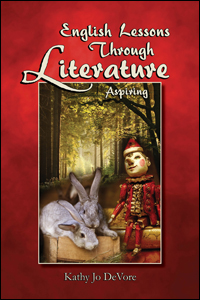 |
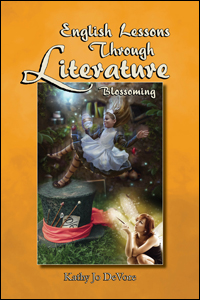 |
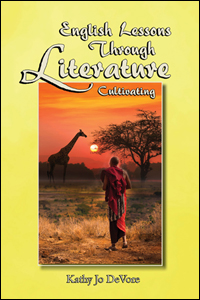 |
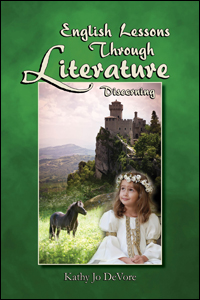 |
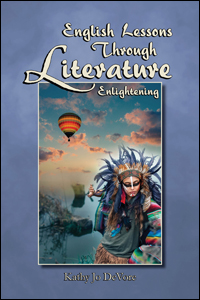 |
 |
 |
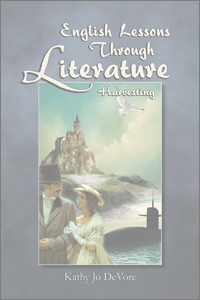 |
Level A: Aspiring
Recommended Grade: 1st or 2nd. Level A is an intentionally light program written with the beginning reader in mind. The real star of the show is the copywork.
Short lessons point out punctuation and capitalization while establishing a habit of doing grammar lessons each week. Level A also introduces nouns, pronouns, verbs, and adjectives in the second half of the book.
Composition begins with picture narrations and continues with oral narrations in the second half of the book. The stories in Level A are Aesop’s fables.
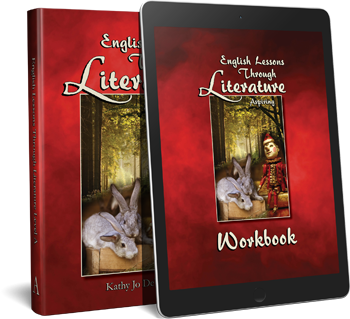 |
Literature in Level A: Beatrix Potter Stories Just So Stories by Rudyard Kipling Five Children and It by Edith Nesbit The Jungle Book by Rudyard Kipling Pinocchio by C. Collodi The Orange Fairy Book by Andrew Lang (seven stories) The Velveteen Rabbit by Margery Williams The Box-Car Children by Gertrude Chandler Warner The King of the Golden River by John Ruskin |
Level B: Blossoming
Recommended Grade: 2nd or 3rd.
Level B teaches all eight parts of speech, and the student practices recognizing them in short passages from the literature.
Composition continues with oral narrations. The stories in Level B are Aesop’s fables.
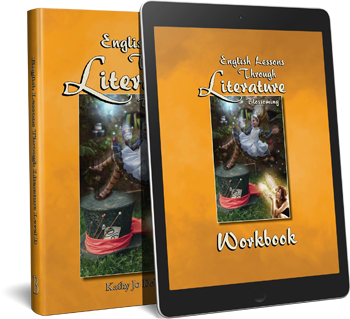 |
Literature in Level B: The Wonderful Wizard of Oz by L. Frank Baum The Blue Fairy Book by Andrew Lang (13 stories) Peter Pan by J. M. Barrie The Wind in the Willows by Kenneth Grahame Alice’s Adventures in Wonderland by Lewis Carroll Through the Looking-Glass and What Alice Found There by Lewis Carroll A Wonder-Book for Girls and Boys by Nathaniel Hawthorne |
.
Level C: Cultivating
Recommended Grade: 3rd or 4th, but it could work for older students who have had little to no grammar and who also need experience with basic narrations.
Level C reviews all eight parts of speech and begins sentence diagramming. Sentence diagramming is an excellent tool for analyzing sentences. In addition, it provides constant review of what the student has already learned. In the optional workbook, students are given the lines at first, making it a “fill in the diagram” exercise. Without the workbook, parents can provide the same by copying the lines from the answer key in the back of the book.
Composition continues with longer narrations. Students can continue to give narrations orally; many students can begin to transition to typed narrations. The stories in Level C are Indian fables.
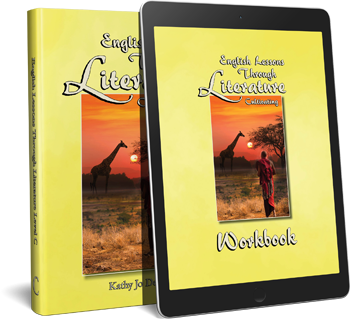 |
Literature in Level C: The Story of Doctor Dolittle by Hugh Lofting The Marvelous Land of Oz by L. Frank Baum Beautiful Stories from Shakespeare by E. Nesbit The Secret Garden by Frances Hodgson Burnett The Princess and the Goblin by George McDonald |
Level D: Discerning
Recommended Grade: 4th or 5th and up. Level D reviews all eight parts of speech and continues sentence diagramming.
New grammar in Level D includes indirect objects and diagramming prepositional phrases, identifying the parts of the verb, and determining whether a group of words is a phrase or a clause.
While the early levels cover composition solely through narration, Levels D and up have an emphasis on progymnasmata, descriptive writing through imitation, and beginning literary analysis. Level D includes one-level outlines. Writing projects include condensed, amplified, point of view, and slant narratives as well as scientific and historical narrations as preparation for writing reports. The stories in Level D are African folktales.
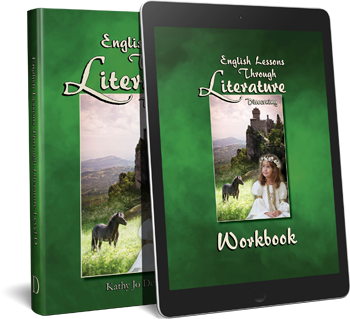 |
Literature in Level D: Black Beauty by Anna Sewell The Book of Dragons by E. Nesbit Heidi by Johanna Spyri Ozma of Oz by L. Frank Baum Tanglewood Tales by Nathaniel Hawthorne The Reluctant Dragon by Kenneth Grahame |
Level E: Enlightening
Recommended Grade: 5th or 6th and up. Level E reviews all eight parts of speech and all new material from the previous level. The pacing in Level E is a bit faster than in previous books.
New grammar in Level E includes types of clauses, sentence structures, diagramming complex and compound sentences, inversion, parallel structure, relative adverbs, interrogative pronouns, and more advanced punctuation. Composition includes progymnasmata, descriptive writing through imitation, and beginning literary analysis.
Composition in Level E includes two-level outlines, introductions, conclusions, writing dialogue, and using quotations. Writing projects include condensed, amplified, point of view, and slant narratives as well as scientific and historical narrations as preparation for writing reports. The stories in Level E are Nasrudin stories from Middle Eastern folklore.
 |
Literature in Level E: “The Ransom of Red Chief” by O. Henry “The Gift of the Magi” by O. Henry The Emerald City of Oz by L. Frank Baum The Adventures of Tom Sawyer by Mark Twain The Happy Prince and Other Tales by Oscar Wilde Little Women by Louisa May Alcott Around the World in Eighty Days by Jules Verne |
Level F: Flourishing
Now available! Recommended Grade: 6th or 7th and up. Level F does not review the parts of speech, but it does review all new material from Level E.
New topics in Level F include appositive adjectives, the perfect aspect, collective nouns, indefinite pronouns, misplaced and dangling modifiers, idioms, and a brief introduction to verbals. Literary terminology terms include protagonist, antagonist, plot and conflict, rising action and climax, falling action and dénouement, setting, perspective, atmosphere, similes, metaphors, onomatopoeia, personification, hyperbole, alliteration, assonance, and consonance.
Composition in Level F covers 3-level outlines, paragraph unity and coherence, transition words, slant narratives, in medias res, reverse chronology, biographical sketches, compare and contrast, and chreia. It also covers introductions and conclusions, basic literary analysis, and literary terminology. Students continue to have a model for every writing project they have. Level F continues to have copia exercises where students practice rewriting sentences. The stories in Level F are Chinese and Japanese fairy tales and legends.
 |
Literature in Level F: At the Back of the North Wind by George MacDonald Call of the Wild by Jack London The Patchwork Girl of Oz by L. Frank Baum Otto of the Silver Hand by Howard Pyle The Adventures of Sherlock Holmes by Sir Arthur Conan Doyle |
Level G: Growing
Recommended Grade: 7th or 8th and up. Level G does not review the parts of speech, but it does review all new material from Level F.
New topics in Level G include intensive and reflective pronouns, objective complements, nominals, noun clauses, verbals (gerunds, participles, infinitives), continuous aspect, perfect continuous aspect, emphatic aspect, modal verbs, when to use different verb tenses, problems with prepositions and infinitives, proofreading marks, using italics, advanced punctuation marks (em dash, ellipsis, and parentheses), and parody.
Composition in Level G covers Theon’s six components, known-new contract, slant narratives, in medias res, reverse chronology, compare and contrast, and two more advanced progymnasmata–chreia and maxim. It also covers basic literary analysis and literary terminology. Students continue to have a model for every writing project they have. Level G also continues to have copia exercises where students practice rewriting sentences. The stories in Level G are American folktales and legends.
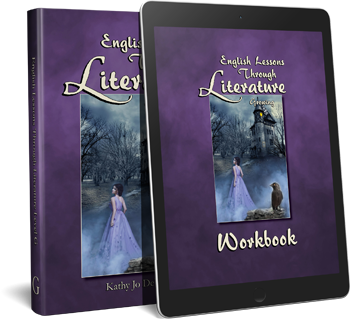 |
Literature in Level G: “Rip Van Winkle” by Washington Irving “The Legend of Sleepy Hollow” by Washington Irving “The Raven” by Edgar Allan Poe “The Tell-Tale Heart” by Edgar Allan Poe “The System of Dr. Tarr and Professor Fether” by Edgar Allan Poe Kidnapped by Robert Louis Stevenson A Christmas Carol by Charles Dickens The Canterville Ghost by Oscar Wilde The Tin Woodman of Oz by L. Frank Baum Northanger Abbey by Jane Austen |
Level H: Harvesting
Coming summer 2019. Recommended Grade: 8th or 9th and up. Recommended Grade: 8th or 9th and up. Level H does not review the parts of speech, but it does review all new material from Level G. Level H covers slant narratives, compare and contrast, and four advanced progymnasmata–chreia, maxim, refutation, and confirmation. It also covers basic literary analysis and literary terminology. The stories in Level H will be Jewish stories from the Talmud, Zen Buddhism stories, and Christian parables; these will be included as literature, rather than as devotional texts, to promote cultural literacy. (See Are your programs Christian or secular?)
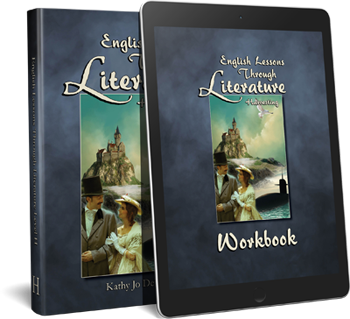 |
Tentative Literature in Level H: The Importance of Being Earnest by Oscar Wilde The Misanthrope by Molière Glinda of Oz by L. Frank Baum Cyrano de Bergerac by Edmond Rostand 20,000 Leagues Under the Sea by Jules Verne A Double Story (also known as The Lost Princess or The Wise Woman) by George MacDonald |
